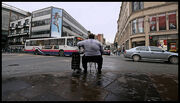
A man sitting down Argyle street

Glasgow Clydeside
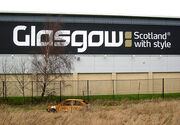
Glasgow scotland with style sign
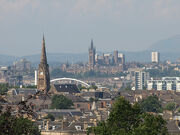
City of Glasgow seen from Queens Park
Glasgow is a city in Scotland, UK. It currently has around 588,000 people living within the city limits and 1.2 million people in the Metro area.
The city of Glasgow contains the highest concentration of tower blocks in the UK - examples include the Hutchesontown estate in the Gorbals, the ten 20-storey blocks in Sighthill, and the famous Red Road tower blocks in Balornock - the tallest social housing estate in Europe when they were built. Many are now earmarked for demolition as part of the cities plans for regeneration. However, 96 tower blocks in Glasgow will also be refurbished in the next ten years as part of a partnership between the Glasgow Housing Association, Wates and 3D Architects. The contract value is worth £83m.
The Victorian years[]
From 1850 to 1910, Glasgow's population boomed. people from the surrounding towns and villages, the Highlands, Ireland and further afield were drawn to the prospect of employment in the Clyde's many shipyards and the enormous Rail yards in Springburn. The population more than doubled to reach 1.1million. To house these vast numbers, tenement housing was erected throughout the city in 3 and 4 storey form. This differed from the terraces built in England. Tenements were chosen because, although Glasgow was now the largest city in Scotland in population terms, it was only the the third largest in terms of size. It would be infeasible to house 1.1 million people in a 15 mile by 10 mile area so building up was the only option. This also allowed landlords to own less land, and house more residents, thus increasing profits.
The Inter-war years[]
The years between 1918 and 1939 saw cracks appearing in the still-growing city's structure. As growth had occurred so quickly, communities were not planned and this led to problems. For example, Glasgow, in Gaelic, means "Dear Green Place". However, with more and more housing being built in a short space of time, green space was a rarity in many communities which, along with overcrowding and close proximity to heavy industry and factories, affected health. Disease spread rapidly and led to high chronic illness and mortality rates. Many tenements, with penny-pinching landlords responsible for their construction, were poorly built and falling apart before residents very eyes.
The 1921 Royal Commission on housing in Scotland found Glasgow to be the most overcrowded city in Europe at the time. Defining overcrowding as 2 people to a room, 39.4% of households were in this state. Population was rising continuously and had more than doubled in the past century, mainly due to emigration from the Highlands and abroad, and registered as 1.1million people of which 700,000 were living on 1800 acres of land in central Glasgow. 1/7 of the population of Scotland were living on 3 square miles. Something had to be done.
While the inter war era saw a boom in private housing construction south of the border, Glasgow, and Scotland in general, regarded council housing as the way forward. This would provide a more uniform and fair service than private-let landlords who had allowed their properties to become run down at the expense of their tenants. 50,000 new council dwellings were built. The first centrally planned housing estates were built by Glasgow City Council at Mosspark in the newly annexed south side and Knightswood in the west end. In these estates, a deliberate departure from tenement housing was made and replaced by semi-detached and cottage flat dwellings. These were brick built and were usually pebble-dashed coated with white paint. These had back and front gardens as opposed to the communal back courts of the inner city tenements. This reduced density and provided more spacious homes built to a better quality. This type of housing was called 'Intermediate' and cost £1000 per dwelling. Rising costs forced the return of tenements towards the end of the 1920s. These were built occasionally using brick/pebbledashing, but in most cases, reconstituted stone, as opposed to sandstone in the Victorian era. These dwellings cost £250 per dwelling and were classed as 'Rehousing' - the lowest grade of council housing.
A further two housing estates were created as part of the 1935 Slum Clearance Act: Blackhill included a mix of both 'Rehousing' and 'Intermediate' while Calton was almost entirely 'Rehousing'.
While these were improvements, they made little difference to the massive overcrowding problem and more had to be done. Plans were put in place for more housing estates and bigger housing estates.
World War II[]
World War II effectively postponed the developments in Glasgow. Trade broke down internationally and a shortage of raw materials meant remained to be spent on housing. Glasgow, luckily, was relatively unharmed by the Luftwaffe in comparison to cities such as Birmingham, London and many others. Industry on the Clyde and railways were affected but not devastated. The neighbouring town of Clydebank was much worse off.
Despite a lack of funds, housing continued to be built. A new housing scheme was built at Penilee on the south side. This was located on the border with Paisley and was similar to Blackhill in that 'Intermediate' and 'Rehousing' were deployed fairly equally. The lack of materials meant these houses did look strange. A shortage in timber for beams meant these flats had flat roofs. Similar housing was built nearby at Cardonald and Mosspark. Roofs were added decades later.
Post War Era[]
The Clyde Valley Regional Plan[]
In the aftermath of war, Glasgow's housing problems once again came to the fore. Delegates were sent to Marseilles, France in 1946 to look at how that city dealt with a similar overcrowding problem. Marseilles had adopted a high rise approach to rehousing with high rise tower blocks accommodating vast numbers of people on a small amount of land. Le Corbusier's Unité d'Habitation inspired Glasgow City Council and convinced them that this could work in their city. However, alternative plans were put into action around Glasgow.
The Clyde Valley Regional Planning Advisory Committee (or CVRPAC) was set up in 1943. This involved representatives from all major settlements along the Clyde (including Glasgow) from Greenock to Hamilton. The Committee appointed Sir Patrick Abercrombie and Robert Matthew as consultants, who presented their Clyde Valley Plan in 1946. The Plan presented the consultants' views as to what should be done about the overcrowding in Glasgow:
- Urban growth of Glasgow limited by a 'Green belt' of rural land that must not be built on. This would eliminate urban sprawl that could happen if Glasgow was to keep building peripheral estates.
- 550,000 (half) of Glasgow's population should be relocated away from the city.
- 4 New Towns built at East Kilbride, Cumbernauld, Bishopton and Houston. These would accommodate around at total of 200,000 people. Despite some growth of surrounding towns to accommodate 'Overspill', this meant that 100,000 Glaswegians were to be jettisoned from the Clydeside altogether.
All towns (with the exception of Milngavie) were to lose a significant proportion of their population, but Glasgow would be the biggest loser.
Needless to say, Glasgow City Council were not pleased with these proposals. They saw the loss of population as not just a loss of tax revenue, but also a loss of 'status'. They were unwilling to go along with anything that could jeopardise the city's position as the "The Second City of the Empire". When East Kilbride accepted its first residents in 1948, it was through gritted teeth by the GCC. They withdrew from CVRPAC and the committee fell apart without the contribution of its biggest member.
Bruce Report[]
Robert Bruce was City Engineer during the period of prearation of the Clyde Valley Plan. He prosed that the City should be entirely reconstructed within its boundaries, without loss of population to any new towns. His views were expressed in his First Planning Report. Bruce wanted to:
- Demolish St Enoch Railway Station (a Victorian building)
- Demolish the City Chambers (He claimed that it was outdated, despite it being an iconic building for the city)
- Create new estates and communities cut off from each other by main roads and expressways
- All major buildings should have flat reinforced roofs to allow helicopters to land on them
- Build a motorway right through the city centre
- Train network should be extended to replace buses
- Demolish and rebuild the entire Centre of Glasgow without 'working class housing'
Most of these suggestions were rubbished at the time and in hindsight are even laughable. Significant progress was also financially impossible at the time and Bruce left office in 1951.
1950s[]
A.G. Jury replaced Bruce as City Engineer. He drew up plans for 135,000 houses to be built. But he also wanted these houses to be built in an open, clean environment that would never become overcrowded. This could only be achieved by overspill to other towns and possibly another New Town in addition to East Kilbride. The GCC admitted this and talked to over 60 local authorities as far away as the Outer Hebrides and Fife about the transfer of Glaswegians away from the city.
In 1955, a second New Town was launched at Cumbernauld with the City Council's support and Glasgow also transferred people to Livingston and Glenrothes, new towns in the east of Scotland. The GCC refused to let people leave the city without attempting to keep as much of them as possible, however, and built the first high rise flats at Moss Heights in Cardonald. This was to be the first of many examples of multi storey tower blocks in the city as the GCC worked to keep as many people within the city limits as possible. Even if this meant going against density levels that A.G. Jury had set. Other multi storey blocks were built in the 1950s at Toryglen and Partick among others.
As a result of Jury's low density levels, this meant building further and further away from the City centre and further into the 'Green Belt' that the CVRPAC had advised not to do. Even by building on the periphery, Glasgow still could not accommodate the massive population at Jury's density levels and tenements once again had to be introduced on a massive scale albeit in a cheap form similar to the inter war years. These were brick-based with pebbledashing and entire estates were constructed with them like 'the big three' at Drumchapel in the west, Easterhouse in the east and Castlemilk in the south. These schemes were built to accommodate as many people as possible. Easterhouse's population numbered nearly 60,000 at the end of the 1950s. However, despite the abundance of homes, there were no job opportunities, no shops, no schools, no community centres, no amenities at all in these tenement deserts. A deprivation that would become more prominent as the years rolled by was already taking root from the moment the residents picked up their keys.
By 1954, despite Jury's figure of 135,000 homes needed long having been surpassed, there were still around 300,000 people needing rehoused.
1960s[]
The 1960s called for a more drastic solution to be made. Land was fast running out and urban sprawl was threatening to consume the New Town of East Kilbride, only 1 mile away from Castlemilk. The overspill program was working but not quickly enough and poverty in the inner city was become more pronounced as the years rolled by. It had been around 38 years since the GCC had decided something had to be done and 38 years on, they were in little better position than where they started from. This called for drastic measures.
29 Comprehensive Redevelopment Areas (or CDAs) were identified. This would mean that massive communities including Gorbals, Pollokshaws, Townhead, Springburn and many others would be razed to the ground to make way for new housing, in the form of multi storey flats. This would result in 100 people per acre densities. Around 4 times over the recommended density. High rise housing was going up all around the city in necessity and a study in 1983 by Gibb found that Glasgow had at least 321 tower blocks of which the vast majority were built in the 1960s. These included the Red Road estate in Balornock, the tallest public housing estate in Europe at the time of its planning which consisted of 8 towers, ranging between 28 and 31 stories.
As yet another decade came and went, still there was a need for 100,000 more houses as the population, which was now down to 800,000 still could not be managed.
1970s[]
The 1970s saw the termination of the CDAs. New peripheral projects were also created at Darnley and Summerston. These were to be the last to be built as there was simply no more room for housing in the city limits. Therefore tenements in these areas would be taller than before, rising up to 8 storeys. 4100 mid rise homes were built in Darnley and Summerston. High rises were also continuing to be built beyond the disbanding of the Corporation in 1975, with the last blocks being built on the Queensland Drive estate in Cardonald. At last, with a population of 700,000 contained within the city boundaries, the GCC could finally breathe easy and admire their work over the past 60 years. However, things took a downturn.
1980s[]
The 1980s was quite possibly the worst decade in the city's history. The economy relied almost entirely on the legendary ship yards on the Clyde and the numerous rail yards in Springburn. However, industrial decline throughout the western world meant that these industries went to the wall. Leaving thousands unemployed and on the dole. There were little opportunities available and many were only trained in the manual labour sector like generations before them. The city had never dealt with this problem before and poverty once again reared its ugly head.
To make matters worse, the cracks began to appear in the housing estates. The growing economic unrest meant that more people were turning to crime as a way of making ends meet or taking out their frustration on others. Brutal assaults, youth crime, gang warfare and theft gained Glasgow its "No Mean City" image. The cracks in the houses themselves began to appear as hasty, haphazard and ill-planned construction meant that entire neighbourhoods were becoming like the slums they replaced. The Hutchesontown Area E estate in Gorbals was the first to be demolished in 1987, having been uninhabited since 1984 due to damp. Once again, housing was becoming a priority.
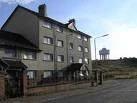
Drumchapel

Easterhouse

Castlemilk
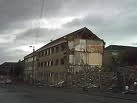
Barrowfield
1990s[]
The 1990s saw the regeneration of the poorly planned estates pick up speed. Vast areas of tenements just a few decades old were razed to the ground. This included Castlemilk - with the unenviable title of the most deprived neighbourhood in the UK. Drumchapel, Easterhouse, Barrowfield, the mid rises at Summerston and Darnley along with the infamous Queen Elizabeth Square multistorey blocks in Gorbals were demolished. 240 Roystonhill is to date the tallest high rise to be demolished in the city, back in 1992. An 18 storey block of flats in Germiston, demolished. 30 Bogany Terrace, demolished. The GCC and the people it was responsible for were paying the price of a flawed vision of a better world.
2000s[]
The 21st century is seeing the ongoing regeneration of much the city. The housing estates are being rehabilitated with new low rise housing. A falling population throughout the country is making the demands on the GCC easier this time, as are private investment and projects. The multi storey flats are either planned for refurbishment or demolition. In the course of the City's development, its population has fallen to around 600,000, or half the level at the end of World War II. The man sitting down in the bench in Glasgow picture is voiced by Harry Sheamus and Dan Thomson
